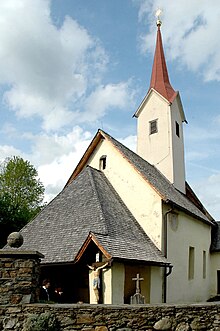St. Bartlmä (Techelsberg am Wörther See)
|
St. Bartlmä ( Rotte ) locality cadastral community St. Bartlmä |
||
|---|---|---|
|
|
||
| Basic data | ||
| Pole. District , state | Klagenfurt-Land (KL), Carinthia | |
| Judicial district | Klagenfurt | |
| Pole. local community | Techelsberg am Wörther See | |
| Coordinates | 46 ° 39 '35 " N , 14 ° 6' 38" E | |
| height | 790 m above sea level A. | |
| Residents of the village | 222 (January 1, 2020) | |
| Building status | 71 (2001) | |
| Area d. KG | 8.56 km² | |
| Statistical identification | ||
| Locality code | 01167 | |
| Cadastral parish number | 72165 | |
| Counting district / district | Techelsberg a. Wörther S. (20 435 000) | |
| Source: STAT : index of places ; BEV : GEONAM ; KAGIS | ||
The place Sankt Bartlmä is located in the municipality Techelsberg am Wörther See at an altitude of 790 meters. It has 179 inhabitants (according to the 2001 census) and belongs to the political district of Klagenfurt-Land .
The Rotte was formerly known as Berg and is located south at the foot of the Gallin, northwest of Pörtschach am Wörthersee .
A well-signposted and marked hiking trail up to the summit of the Hohen Gallins ( 1046 m ) begins between the church and the inn .
Filial church of St. Bartholomew
The little church, surrounded by cemetery walls, was first mentioned in a document in 1363 and represents a Gothic building with an easterly turret. Two-tiered buttresses serve as structural supports on the choir, a sacristy is located on the south side of the choir. The western porch rests on brick pillars, an inscription from 1550 can be seen on the left pilaster. The profiled west portal is late Gothic and the door fittings themselves are Gothic.
Interior
A flat ceiling spans the nave. The window openings are baroque in nature. A pointed triumphal arch separates the nave from the chancel . Choir bay and polygonal end as well as ribbed vaults on consoles shape the interior. Two Gothic windows with tracery noses let daylight into the interior. A chamfered Gothic vestry portal leads into the groin-vaulted sacristy. Recognizable wall painting remains on the north wall show, among other things, the epiphany , the crucifixion from the 14th century and Sebastian Artomedes from the 16th century.
Furnishing
The high altar dates from the middle of the 17th century. An aedicule rests on a small base; the small style element with the split-segment gable bears a crowning figure as an attachment; a carving group from the 19th century, which was restored in 1861, shows the torture of St. Bartholomew , in the essay the eye of the beholder can see figures of a baroque Maria Immaculate , the late Gothic saints James the Elder and Alexius (made around 1500), above St. Simon, also around 1500. The left side altar shows a crucifix between Mary and John in the niche , in front of it a figure of St. Bartholomew from the 18th century. The right side altar houses a figure of the Madonna, made around 1500, as well as carved figures of Saints Peter and Paul, also around 1500. A carved sculpture from the same date shows the coronation of Mary.


